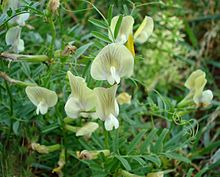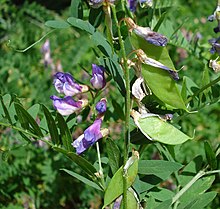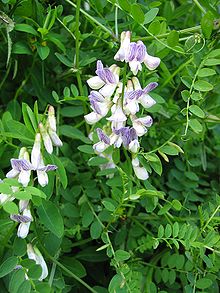Sweet peas (Vicia)
| Sweet peas | ||||||||||||
|---|---|---|---|---|---|---|---|---|---|---|---|---|

Fence vetch ( Vicia sepium ) |
||||||||||||
| Systematics | ||||||||||||
|
||||||||||||
| Scientific name | ||||||||||||
| Vicia | ||||||||||||
| L. |
The vetch ( Vicia ) are a genus of plants in the subfamily of butterflies (Faboideae) within the family of legumes (Fabaceae). The approximately 160 species occur mainly in the northern temperate areas.
The sweet pea ( Lathyrus odoratus ), which is occasionally referred to as "sweet peas" or "garden pea", does not belong to the genus Vicia , but is a species of the genus flat peas ( Lathyrus ).
description
Vegetative characteristics
Vicia species are annual or perennial herbaceous plants . The mostly thin and branched stems can be upright on their own, in some species they are overhanging, but many species have winding tendrils with which they climb up other plants.
The alternate, stalked leaves are usually pinnate in pairs. The rachis ends in a tendril or a spike tip; in Vicia subvillosa it ends with a leaflet, so this species is pinnate unpaired. There are 1 to 13 pairs of ganzrandigen pinna flake available. The stipules have a smooth or toothed edge.
Generative characteristics
The flowers stand individually to a few in the leaf axils or in lateral, racemose inflorescences . Small bracts are present, but can fall off early; Cover sheets are missing.
The hermaphrodite flowers are zygomorphic and five-fold with double perianth . The five dissimilar to the same sepals are fused bell-shaped and often hairy, with at least two calyx teeth less than twice as long as the calyx tube. The five petals are arranged in the typical structure of the butterfly flowers. The colors of the petals range from many shades of blue to purple to red, yellow or white. The flag is nailed. There are ten stamens with thin stamens. The individual carpels contain two to eight ovules . The pencil-shaped stylus is hairy.
The flattened legume contains two to eight seeds. The mostly spherical to elongated seeds have an often elongated hilum and a thin aril .
distribution
The distribution area mainly includes the temperate climatic zones of the northern hemisphere , but also reaches the South American Andes , tropical Africa and Hawaii .
Systematics











The genus Vicia L. belongs to the tribe Fabeae, Syn . : Viciae DC. The genus Vicia was published in 1753 by Carl von Linné in Species Plantarum . Synonyms for Vicia L. are: Bona Medik. , Ervilia Link , Ervum L. , Faba Mill. , Vicilla Schur , Vicioides Moench .
The genus Vicia is named after G. Lewis, et al., Eds .: Legumes of the world. (Leg World), 2005, 506 divided into two sub-genera with 26 sections with about 160 species. Here is a selection of the types:
- Subgenus Vicia : With nine sections:
- Section Atossa (Aleph.) Stank. :
- Vicia balansae Boiss.
- Vicia oroboides Wulfen
- Vicia sepium L.
- Section Bithynicae (B.Fedtsch. Ex Radzhi) Maxted :
- Vicia bithynica (L.) L.
- Section Faba (Mill.) Ledeb.
- Vicia faba L.
- Section Hypechusa (Aleph.) Asch. & P. Graebn.
- Vicia anatolica Turrill (Syn .: Vicia hajastana Grossh. )
- Vicia assyriaca Boiss.
- Vicia ciliatula Lipsky
- Vicia galeata Boiss.
- Vicia hybrida L.
- Vicia hyrcanica fish. & CAMey.
- Vicia lutea L.
- Vicia melanops Sm.
- Vicia noeana Reut. ex Boiss.
- Vicia pannonica Crantz
- Vicia sericocarpa Fenzl
- Section Microcarinae Maxted :
- Vicia dionysiensis Mouterde
- Section Narbonenses (B.Fedtsch. Ex Radzhi) Maxted :
- Vicia galilaea Plitmann & Zohary
- Vicia Johannis Tamamsch.
- Vicia hyaeniscyamus Mouterde
- Vicia narbonensis L.
- Vicia serratifolia Jacq.
- Vicia kalakhensis Khattab et al.
- Section Peregrinae Kupicha :
- Vicia aintabensis Boiss. & Hausskn.
- Vicia michauxii Spreng.
- Vicia peregrina L.
- Vicia Section :
- Vicia grandiflora Scop.
- Vicia incisa M.Bieb.
- Vicia pyrenaica Pourr.
- Vicia sativa L.
- Section Wiggersia (Alef.) Maxted :
- Section Atossa (Aleph.) Stank. :
- Subgenus Vicilla (Schur) Rouy : With 17 sections:
- Section Americanae Kupicha :
- Vicia americana Muhl. ex Willd.
- Section Australes Kupicha :
- Vicia andicola Kunth
- Vicia bijuga Gillies ex Hook. & Arn.
- Vicia epetiolaris Burkart
- Vicia graminea Sm. (Syn .: Vicia selloi Vogel )
- Vicia linearifolia Hook. & Arn.
- Vicia macrograminea Burkart
- Vicia montevidensis bird (Syn .: Vicia obscura bird )
- Vicia nana bird
- Section Cassubicae Radzhi :
- Vicia abbreviata fish. ex explos.
- Vicia cassubica L.
- Vicia menziesii Spreng.
- Vicia multicaulis Ledeb.
- Vicia nigricans Hook. & Arn.
- Vicia orobus DC.
- Vicia semiglabra Rupr. ex Boiss.
- Section Cracca (medic.) Dumort.
- Vicia acutifolia Elliott
- Vicia alpestris Steven
- Vicia benghalensis L. (Syn .: Vicia albicans Lowe , Vicia atropurpurea Desf. , Vicia loweana Steud. , Vicia micrantha Lowe )
- Vicia caroliniana Walter
- Vicia cirrhosa C.Sm. ex Webb & Berthel.
- Vicia cracca L.
- Vicia disperma DC. (Syn .: Vicia parviflora Loisel. )
- Vicia filicaulis Webb & Berthel.
- Vicia floridana S. Watson
- Vicia hirsuta (L.) Gray
- Vicia ludoviciana Nutt.
- Vicia minutiflora D.Dietr. (Syn .: Vicia micrantha Nutt. Ex Torr. & A.Gray )
- Vicia monantha Retz. (Syn: Vicia biflora Desf. , Vicia calcarata Desf. )
- Vicia ochroleuca Ten.
- Vicia palaestina Boiss.
- Vicia pulchella Kunth
- Vicia scandens R.P. Murray
- Vicia sicula (Raf.) Cast.
- Vicia tenuifolia Roth (Syn .: Vicia elegans Guss. , Vicia variabilis Freyn )
- Vicia villosa Roth
- Section Ervilia (Link) W. Koch
- Vicia ervilia (L.) Willd.
- Section Ervoides (Godr.) Kupicha :
- Vicia articulata Hornem. (Syn .: Ervum monanthos L. , Vicia monanthos (L.) Desf. )
- Section Ervum (L.) Taub.
- Vicia parviflora Cav. (Syn .: Ervum gracile DC. , Vicia gracilis Loisel. , Vicia laxiflora bread. , Vicia tenuissima auct., Vicia tetrasperma subsp. Gracilis (DC.) Hook. F. )
- Vicia pubescens (DC.) Link
- Vicia tetrasperma (L.) Schreb. (Syn .: Ervum tetraspermum L. , Vicia gemella Crantz )
- Section Lentopsis Kupicha
- Section Mediocinctae Kupicha
- Section Panduratae Kupicha :
- Vicia cappadocica Boiss. & Balansa
- Vicia cretica Boiss. & Hero.
- Section Pedunculatae :
- Section Perditae Kupicha
- Section Subvillosae Kupicha
- Trigonellopsis Section :
- Vicia cypria Kotschy
- Section Variegatae Radzhi :
- Vicia canescens Labill.
- Vicia megalotropis Ledeb.
- Section Vicilla (Schur) Asch. & P. Graebn.
- Vicia amoena fish.
- Vicia amurensis Oett. (Syn .: Vicia pallida Turcz. )
- Vicia crocea (Desf.) B. Fedsch. (Syn .: Orobus aurantius Steven ex M.Bieb. , Orobus croceus Desf. , Vicia aurantia (Steven ex M.Bieb.) Boiss. )
- Vicia dumetorum L.
- Vicia japonica A. Gray
- Vicia nipponica Matsum.
- Vicia pisiformis L.
- Vicia pseudo-orobus fish. & CAMey.
- Vicia sylvatica L.
- Vicia unijuga A. Brown
- Vicia venosa (Willd. Ex Link) Maxim.
- Section Volutae Kupicha :
- Vicia biennis L. (Syn .: Vicia picta fish. & CAMey. )
- Section Americanae Kupicha :
species
There are around 120 to 150 species of Vicia worldwide (selection).
- In Central Europe, among others:
- Single-flowered vetch or Algaroba lentil ( Vicia articulata Hornem. , Syn .: V. monanthos (L.) Desf. , V. monantha Koch , Vicia multifida Wallr. ): They are eaten, for example, under the name "black lentils".
- Purple vetch ( Vicia benghalensis L. , Syn .: Vicia albicans Lowe , Vicia atropurpurea Desf. , Vicia loweana Steud. , Vicia micrantha Lowe nom. Illeg., Cracca atropurpurea (Desf.) Gren. & Godron )
- Cassube vetch ( Vicia cassubica L. )
- Bird vetch ( Vicia cracca L. )
- Hedge vetch ( Vicia dumetorum L. )
- Lentil vetch , vetch, stone lentil, bitter vetch, Erfe or Ervilie ( Vicia ervilia (L.) Willd. )
-
Field bean ( Vicia faba L. , Syn .: Faba bona Medik. , Faba vulgaris Moench ): With the varieties:
- Broad Bean ( Vicia faba var. Equina Pers. )
- Broad bean or broad bean ( Vicia faba var. Faba , Syn .: Faba vulgaris var. Major Harz , Vicia faba var. Major (Harz) Beck )
- Field bean ( Vicia faba var. Minuta (hort. Ex Alef.) Mansf. , Syn .: Faba vulgaris var. Minor Harz , Faba vulgaris var. Minuta hort. Ex Alef. , Vicia faba var. Minor (Harz) Beck )
- Large-flowered vetch ( Vicia grandiflora Scop. )
- Wire- haired vetch , Ervenlinse, Hairy vetch, trembling lens or trembling vetch ( Vicia hirsuta (L.) Gray )
- Spring dwarf vetch , sand vetch or flat pea vetch ( Vicia lathyroides L. )
-
Yellow vetch ( Vicia lutea L. , Syn .: Vicia laevigata Sm. ): With the subspecies:
- Vicia lutea subsp. lutea
- Vicia lutea subsp. vestita (Boiss.) Rouy (Syn .: Vicia hirta Balb. ex DC. , Vicia vestita Boiss. )
- Esparsette vetch ( Vicia onobrychioides L. )
- Heath vetch ( Vicia orobus DC. )
-
Hungarian vetch or Pannonian vetch ( Vicia pannonica Crantz ): With the subspecies:
- Vicia pannonica subsp. pannonica
- Striped vetch ( Vicia pannonica subsp. Striata (M.Bieb.) Nyman , Syn .: Vicia striata M.Bieb. )
- Pea vetch ( Vicia pisiformis L. )
-
Vicia sativa L .: With the subspecies:
- Vicia sativa subsp. amphicarpa (L.) Batt. (Syn .: Vicia amphicarpa L. )
- Vicia sativa subsp. cordata (Wulfen ex Hoppe) Batt. (Syn .: Vicia cordata Wulfen ex Hoppe )
- Vicia sativa subsp. macrocarpa (Moris) Arcang. (Syn .: Vicia macrocarpa (Moris) Bertol. )
- Narrow-leaved vetch , narrow-leaved fodder vetch or seed-fodder vetch ( Vicia sativa subsp. Nigra (L.) Ehrh. , Syn .: Vicia angustifolia L. , Vicia pilosa M.Bieb. , Vicia segetalis Thuill. )
- Real forage vetch, forage vetch or seed vetch, field vetch. ( Vicia sativa subsp. Sativa , Syn .: Vicia alba Moench , Vicia leucosperma Moench , Vicia sativa var. Leucosperma (Moench) Ser. , Vicia sativa var. Obovata Ser. )
- Fence vetch ( Vicia sepium L. )
- Forest vetch ( Vicia sylvatica L. )
-
Vicia tenuifolia Roth (Syn .: Vicia elegans Guss. , Vicia variabilis Freyn ): With the subspecies:
- Dalmatian vetch or Dalmatian vetch ( Vicia tenuifolia subsp. Dalmatica (A.Kern.) Greuter , Syn .: Vicia dalmatica A.Kern. )
- Fine-leaved vetch , thin-leaf vetch, narrow-vetch ( Vicia tenuifolia subsp. Tenuifolia , Syn .: Vicia brachytropis Kar. & Kir. , Vicia cracca subsp. Tenuifolia (Roth) Bonnier & Layens )
- Vicia tenuifolia subsp. villosa (Batt.) Greuter (Syn .: Vicia tenuifolia f. villosa Batt. )
- Four-seeded vetch ( Vicia tetrasperma (L.) Schreb. )
-
Vicia villosa Roth : With the subspecies and varieties:
- Vicia villosa var. Gore
- Vicia villosa subsp. eriocarpa (house knot) PWBall (Syn .: Vicia eriocarpa (house knot ) Hal. )
- Vicia villosa subsp. pseudocracca (Bertol.) Rouy (Syn .: Vicia pseudocracca Bertol. )
- Vicia villosa , Hairy Vetch or sand-vetch ( Vicia villosa subsp. Villosa )
- Colorful vetch ( Vicia villosa subsp. Varia (Host) Corb. , Syn .: Vicia varia host , Vicia dasycarpa Ten. )
use
Some types of vetch are used for agriculture in Germany:
- Lentil vetch ( Vicia ervilia )
- Forage vetch ( Vicia sativa )
- Shaggy vetch ( Vicia villosa )
The field bean ( Vicia faba ), also known as broad bean or horse bean (formerly also called "Vietzebohne"), is also a vetch species, in contrast to the common beans , which belong to the genus Phaseolus .
Eponyms
The asteroid (1097) Vicia , discovered on August 11, 1928, is named after the plant genus.
See also
swell
- Syed Irtifaq Ali: Flora of West Pakistan 100: Papilionaceae. Stewart Herbarium, Rawalpindi 1977, p. 265, ( online ).
- Bojian Bao, Nicholas J. Turland: Vicia. In: Wu Zheng-yi, Peter H. Raven, Deyuan Hong (Eds.): Flora of China . Volume 10: Fabaceae . Science Press / Missouri Botanical Garden Press, Beijing / St. Louis 2010, ISBN 978-1-930723-91-7 , pp. 560 (English, online ). (Section description)
Individual evidence
- ↑ Carl von Linné: Species Plantarum. Volume 2, Lars Salvius, Stockholm 1753, p. 734, digitized
- ^ A b c Vicia in the Germplasm Resources Information Network (GRIN), USDA , ARS , National Genetic Resources Program. National Germplasm Resources Laboratory, Beltsville, Maryland.
- ^ Karl Ernst Hermann Krause : The bean and the Vietzebohne. In: Yearbook of the Association for Low German Language Research 16, 1890, p. 53 ff.
- ^ Dictionary of Minor Planet Names, Volume 1 in the Google Book Search
Web links
- Walter H. Schuster: Legumes for grain use : information on the genus. (German)
- Names in the genus Vicia .
